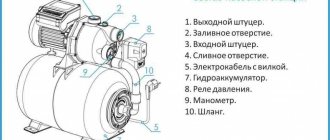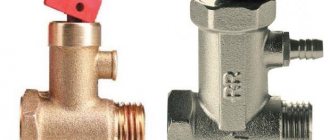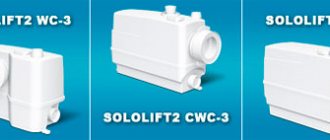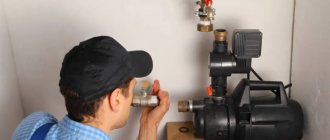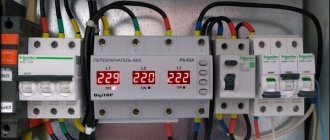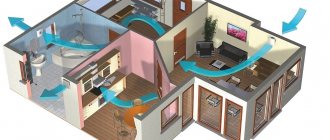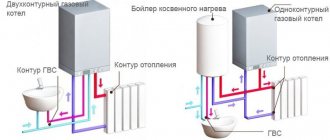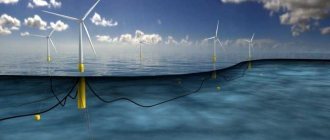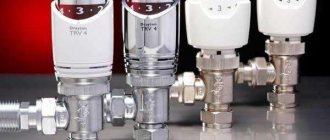During the installation of equipment for wells, submersible structures are often used. But surface aggregates are often used. The described structures are not lowered into water, so their body is not exposed to the negative effects of the environment. Surface devices are divided into vortex and centrifugal. The first type of devices is used to lift water with increasing pressure, and the second are designed to lift liquid from shallow wells. It is worth remembering that if an artesian well is created on the site, it is worth purchasing more expensive and powerful equipment, since only powerful units are capable of lifting water from a depth of more than 20 meters.
Concept and typology of wells
A well is a excavation of soil on the surface of the earth, shaped like a cylinder and directed inward until the desired water layer is reached. Its drilling is carried out using heavy drilling equipment. The depth of the structure significantly exceeds its diameter.
The shaft can be drilled at right angles to the surface of the earth and with the necessary deviation in the desired direction. Thus, it is possible to obtain a curved profile and achieve better water quality. Drilling technology makes it possible to achieve the desired result in a short time.
Exploration mine
This type of well has a smaller diameter; drilling is usually carried out using the fastest and most cost-effective rotary method, or auger (if the well depth is less than 50m). If the mine is supposed to be deep, the core method is used. Using an exploration well, the following operations are carried out:
- the depth of the aquifer is measured
- take soil samples from the aquifer to determine its water capacity and water quality level
- take soil samples from the waterproof layer to find out the degree of its reliability, determine the possibility of subsidence of the excavation or its filling
Often, after the formation of an exploration mine, a compromise solution is chosen for further work - in this case, an already dug well is expanded to the size of a production one. This option is more economically profitable than drilling a new well
Types of wells by profile
The mine may cross several layers of soil before reaching the mineral deposit. It is important to choose the right method for drilling a well. Depending on the number of planes where the shaft is curved, there may be the following types of wells:
- curved in a plane;
- curved in space.
It depends on the bend of the shaft. In this regard, curvature in the plane can have the following varieties:
- a flat column ending in a slope at the bottom;
- S - shaped bend;
- J - shaped design.
These bends are formed as a result of different densities of soil layers. In turn, curvature in space can manifest itself in more complex geometric forms when drilling oil and gas wells. Water shafts are mostly made straight; bends can be used to bypass rocks.
Abyssinian well
Abyssinian well for water.
The tube well got its name from the area in Africa where the technology for extracting groundwater from the depths of the earth without the use of special equipment was first used.
Self-drilling of wells is done in this ancient way. Water intake is carried out from a depth of 8-13 m.
Sequence of work:
- A drill string is assembled from 1-2 m sections of Ø2″ pipes, which will also serve as a casing. The filter drill is made by flattening the downhole end of the first pipe or by attaching a cone to the rod for better penetration into the soil. 6-8 mm holes are drilled into the walls of the drill so that water can flow into them, and they are wrapped in a metal filter mesh.
- The impact head is made from a Ø100 mm guide pipe, 1 m long, weighted with metal weighing 10 kg, and handles are welded on both sides.
- The drill-filter is driven entirely into the ground, after which the next section of the column is attached to it by welding or a threaded connection. Having hammered the pipe after the drill, the operation is repeated until the filter penetrates into the aquifer.
- A manual or electric vacuum pump is connected.
The tube well is pumped until clean water appears. The quality of the liquid is checked in the laboratory of the sanitary and epidemiological station.
Advantages and disadvantages
The advantage of the Abyssinian water intake is the ability to build it yourself with minimal investment. The needle well is completely isolated from the influx of perched water. A tube well can be driven into the ground from the basement of your house.
There are few disadvantages:
- impossibility of using a submersible pump due to the small diameter of the column;
- the need to clean the well from sand and silt;
- restrictions on soil properties: the method is used on soft rocks and coarse sands.
The service life of the water intake is ≥30 years. A prerequisite for long-term performance is the periodic removal of silt and sand from the casing. This is done using a bailer - a cylindrical vessel with a valve seal.
Types of wells by depth
To produce your own water intake, an important factor is reaching a certain aquifer. In turn, each of them is located at a different depth:
- The first is the “overwater”, which consists of precipitation and groundwater. Depending on the terrain, their depth can reach 25 meters. This water is not suitable for drinking; it can be used for caring for a personal plot and watering a vegetable garden. To reach a depth of up to 10 meters, a driving well is used, which is a thick-walled pipe with a conical tip, immersed in the ground by impact.
- The second water is located at a depth of 40-90 meters between the first and second layers of loamy soil. This aquifer is the most popular in the domestic sector. The average productivity of such a mine is 0.8-1.2 cubic meters. m/hour, which is quite enough to meet the needs of a family living in a country house. This water can be used as drinking water after additional filtration. Drilling such a well does not require a permit, and you will not have to pay a quarterly tax for the water consumed.
- The purest artesian water is found at a depth of up to 200 meters, located in a layer of limestone. Natural pressure at such a depth spontaneously pushes water to the surface. The productivity of such water intake can be 3-10 cubic meters. m/hour, which will be enough for a full life for several families. The water is potable and may contain dissolved minerals.
Despite the declared quality of water, before drinking it it is necessary to check it at the SES.
How does the installation work?
Installation of the electric pump is quite simple. In order to start using the device, you only need to select a location for installation and then connect the pipes. To perform such work, it is not necessary to hire specialists, but to install the pump you must have minimal experience working with plumbing equipment.
The pump is installed as follows:
- At the first stage, the location for the equipment to be installed is selected. It is best to prepare a separate structure for installation. It is worth placing it near the well. It is worth remembering that it is necessary to insulate the created structure.
- After this, a concrete foundation for the mechanism is created. Metal fasteners for the described equipment are installed in the base. Metal studs allow you to neutralize the load that constantly affects the structure during operation. If equipment is not protected, vibration can cause it to become unusable in a short time. At this same stage, the installation of a surface electric pump occurs.
- Then the equipment is installed to control the unit. Many automatic systems are already configured and ready for installation. If you have the knowledge, you can assemble the pump control unit in parts. If you are not familiar with the structure of such mechanisms, you should not assemble them yourself. This unit includes sensors as well as control relays that control the water level and other parameters. When the water supply stops, the relays help stop the pump.
- The next step is to connect the pump pipe to the water supply system. During connection, it is necessary to install a check valve on the pipeline. This device prevents water from overflowing and draining after the pump is turned off.
- Then the expansion tank is installed. Before you start connecting, you should check the pressure in the chamber. This indicator must correspond to that declared by the manufacturer. If the pressure does not match, it must first be adjusted.
- At the last stage, the cables for the installed surface electric pump are connected. In this case, it is important to make a dedicated line for supplying electricity.
After connecting the surface pump to the well, it is necessary to check its functionality before turning it on for continuous pumping of water.
Existing well categories
According to the purpose of the well, there are the following categories:
- Parametric - allowing you to determine the section of the vertical layer.
- Exploration - have a small diameter, determine the prospects of drilling.
- Exploration - determine the potential of minerals.
- Exploitation - capable of extracting minerals from the bowels of the earth.
Wells for water extraction are operational and are divided into additional types:
- producing or injection;
- specialized for industrial and drinking water, including absorbing water;
- for monitoring and surveillance of reservoir pressure;
- backups for production;
- estimated during operation.
Each of them has its own characteristics during drilling and during use.
Surface pumps - what are they?
There are two types of pumps – submersible and surface pumps. You can guess their differences from the name, but to better understand the difference between these devices, you need to know their important characteristics. We will not understand the design, but will only discuss the most important differences.
Pumping station – pump and hydraulic accumulator
A surface pump is a device that belongs to the category of self-priming equipment. The maximum height to which it is capable of lifting water from the bottom of the well is 10.3 meters - this is a calculated value derived as the maximum possible at normal atmospheric pressure. In fact, this value is at an even lower level - about 8 meters, since the operation of the equipment is influenced by various factors that cause power losses.
Pump and external ejector
8 meters is, of course, not enough to extract high-quality water suitable for drinking, so this equipment is supplemented with remote ejectors - devices that help increase the lifting depth to 40 meters.
Ejector
The average productivity of a surface pump is not at a very high level - from 1 to 4 cubic meters per hour , but this is absolutely enough to meet all the household needs of even a large family.
A surface pump sucks water from a well through a pipe
The operating pressure that the equipment creates also varies greatly from model to model. Simple devices have a reading of about 2 Bar, while more powerful ones can reach up to 5, which is equal to 20 and 50 meters of water column, respectively.
Submersible pumps are lowered directly to the bottom of the well and controlled by a remote unit. They do not draw in water, but push it into the pipeline system, which makes it possible to use such equipment even in very deep wells. 200 meters is not the limit for them, but this applies to industrial equipment. For domestic use, you simply select a model of the required power for the depth of your well.
Submersible pump
Such equipment can provide very high water consumption - an average productivity of about 10-15 cubic meters.
What types of submersible pumps for wells are there, their technical characteristics, prices and, of course, the main criteria for choosing such equipment. We will try to fully answer these important questions in a special article.
Comparison of surface and submersible pump
Which option should you give preference to on your site if the well depth is suitable for both types? Let's try to understand this issue. We need to know the following.
- In terms of reliability, it is impossible to talk about any difference, since both can be of high quality or downright bad. The most important thing here is to look at the manufacturer, equipment components, service, and so on.
- The main weak point of the two types of pumps is the electric motor, which can suffer due to overheating, bearing wear, short circuits and other things. Interesting to know! The liquid in which it is immersed is responsible for cooling the submersible pump. The surface one is cooled by an impeller mounted on a shaft and driven by the same motor.
- It is much more important to find out the consumed and output power of the equipment, and correlate them with the maximum possible water consumption in your home. For example, in the summer you will want to constantly water the garden.
- Here submersible equipment comes forward, since it spends less effort to lift water than surface equipment, and the greater the depth, the greater the difference. For a well 15 m deep, the difference in consumption will be about 25-30%.
Compact pumping station for a small house and irrigation organization - The next important point is station maintenance. Here surface equipment takes the lead, since in order to get to it, you just need to open the hatch and go down inside the caisson in which everything is installed. The simpler design of the ground pump also affects this factor. It is very difficult to disassemble a submersible pump without knowledge of the device and the availability of specialized tools. It is also difficult to put it back together, since this device has very high requirements for the tightness of the housing - they made a mistake, suffered an instant failure of the equipment, and were left without water at all.
- In terms of price, of course, it is more profitable to take surface stations, but if you have a constantly high water consumption, then the difference in the initial cost is leveled out over time due to savings on electricity.
In general, you will decide for yourself what to buy, and we continue to introduce you to surface equipment.
Types of surface pumps
We have already mentioned in passing that the surface pump is a self-priming equipment. This means that it can independently remove air from the pipes, which is not possible for submersible and circulation pumps, which together are called normal suction pumps.
Pumping station and various types of plumbing connections
A standard surface station includes not only a pump, but also other elements:
- A hydraulic accumulator or membrane tank in which a certain volume of water is stored to maintain normal pressure in the pipeline.
- Suction pipe.
- Outlet pipe.
- Shut-off valves for control and measurements.
- Filter system.
Supplying water to the house with a surface pump
All surface pumps are vane pumps, but the liquid can move in different ways in the working chamber. According to this parameter, pumps are divided into vortex and centrifugal. What is the fundamental difference?
Centrifugal pump
A centrifugal pump has a constantly rotating impeller consisting of two disks installed in parallel. There are blades between them. The parts rotate in different directions.
Centrifugal pump Pedrollo
Several such wheels can be installed in the system, which determines the power of the device and its purpose. In appliances used in everyday life, the wheels and motor have a common shaft and are located in the same housing. In industrial equipment, a separate layout is more often used, but all parts are always installed on the same frame. The engine is connected to the working shaft through a belt or transmission drive.
In principle, this is all that the user needs to know about such pumps, since the rest of their capabilities relate to industrial equipment.
Vortex pump
In a vortex pump, despite the presence of blades, water moves in a different direction and according to a different principle. The working chamber has a ring shape; the discharge and pressure pipes are connected to the channel, separated by a seal. As water passes through, it twists into a double screw, like a chain of DNA. Due to the centrifugal force from the action of the screw, it enters the outlet pipe, in which the acceleration force of the water is converted into a pressure force.
Vortex pump called “Vortex”
In a centrifugal pump, water moves along the shaft, and after passing the wheel, it can immediately change directions to axial, radial or perpendicular, which depends on the design of the unit.
Vortex pumps are capable of creating very high pressure, but they are characterized by large energy losses, and as a result, the efficiency drops significantly compared to centrifugal pumps. Therefore, they are given preference only when there is no other choice, or when a really powerful pressure is needed.
The vortex pump has a compact body
Another advantage of a vortex-type station is its ability to better pump liquids with a high content of water-insoluble impurities, such as sand or clay. So, if you need water not for drinking, but, for example, for irrigation, and you do not intend to install a filter system, vortex units are what you need.
Basic parameters for choosing a pump
So, we have already written about the height to which the water needs to be raised. What else should you pay attention to when choosing? We need to know exactly the distance of the well from the house, and the volume of pumped liquid, which will depend on the total volume of the water supply network and the maximum possible water consumption at any given time. A trivial example: we open the tap closest to the point of entry into the building - we get good pressure, open the second one - the pressure drops, and at a remote point the water flow will be the smallest.
Pump inside a wooden frame structure
The calculations here are, in principle, not complicated; you can do them yourself by using an online calculator, or simply by studying the instructions from the manufacturer.
Advice! Household appliances that work with water need to constantly maintain the pressure in the pipeline at a level of at least 0.3 Bar. Consider this point also when choosing a pumping station.
What does the pressure in the system depend on? It depends on the power of the pump and the volume of the hydraulic accumulator - the larger it is, the more stable the average pressure in the water supply. The fact is that when turned on, the pump does not work constantly, since it requires cooling, and when the operating pressure is reached, it should not continue to increase it. The system is designed in such a way that it pumps water into a hydraulic accumulator, in which a check valve is installed, which prevents water from flowing back when the pump is turned off. When the pressure in the tank reaches the set threshold, the pump stops. If water withdrawal continues, it will gradually drop, reaching a minimum level, which is a signal to turn on the pump again.
Diaphragm tank - the stability of the pressure in the tap depends on it
That is, the smaller the accumulator, the more often the pump is forced to turn on and off, the more often the pressure will rise and fall. This leads to accelerated wear of the engine starting equipment - in this mode the pumps do not last long. Therefore, if you plan to use water from a well constantly, buy a tank with a larger capacity for the pumping station.
Water supply to the house from a well
When constructing a well, a casing pipe is installed into it, through which water rises. This pipe can be of different diameters, that is, it may have different throughput. Based on the cross-section of the casing pipe, you can also choose the right equipment for your home.
Interesting to know! The most popular casing pipe size today is 100 mm.
All the necessary information will be in the instructions for the purchased pump. You can also get recommendations from the specialists who are drilling your well. They will know exactly the optimal operating parameters. It will also not be superfluous to make some reserve in the power of the unit so that the pressure in the system rises faster to a comfortable threshold, otherwise water will constantly flow sluggishly from the tap.
Structural types of wells
The designs used divide wells into types:
- with one column;
- with two columns.
The above types of wells imply the number of pipes during drilling and operation of the mine.
The simultaneous use of casing and production pipe is considered a more expensive option, but allows for longer service life. In this case, even an artesian well can have an internal PVC pipe.
Types of gravel filters that are placed:
- between the rock and the water intake pipe with a bottom plug;
- between the casing and water intake columns with a bottom plug;
- in the bottomhole zone, taking into account the flow of water through the bottom of the water intake pipe.
Each of the above filters has its own characteristics and advantages.
Installation stages
Installation diagram
To correctly install a surface pump on a water supply well, in addition to the electric pump itself, you need a hydraulic accumulator, automatic start and stop, a pressure switch and a pressure gauge, as well as a mesh filter element and a non-return valve. You can select additional elements yourself or purchase a complete installation. Fitting elements and pipe sections with a cross-section of 32 or 25 mm are also needed for input and output.
Pipes are purchased in such a way that at least 30 cm of the lower part is under the water surface. The overall size should not be larger than specified in the instructions for the unit.
At the location where the pressure equipment is installed, it is necessary to build a reliable pedestal or fittings to which the frame of the unit is rigidly attached. It should have mounting holes or legs. To reduce vibration and noise, a rubber mat is placed under the device.
Installation of a surface pump on a well is carried out using the following technology:
- A piece of polyethylene pipe of the required length is cut.
- At one end of the pipe section, a coupling made of brass or plastic with internal thread, a nipple and a non-return valve are installed.
- Additionally, the system is equipped with a mesh filter for coarse cleaning.
- On the opposite side, the pipe is equipped with a coupling and connected to the station inlet. Often the inputs have an internal thread; it is sealed with FUM tape or plumbing flax.
For ejector models, installation of a recirculation system hose is required.
Specific types of water wells
There are different types of wells:
- Constructed on quicksand, it can have a recess of 40 meters. Parallel drilling with installation of casing pipes is used. This design allows you to obtain a larger volume of water, unlike the standard design.
- A geothermal well is drilled to extract water from an underground hot spring. It is used for autonomous heating when heating homes. Hot water rises to the heat pump on its own. The idea is to use hot water to heat a room and drain it back to the source. Thus, the room receives free heating.
As you can see, the main types of wells differ not only in their design and depth, but also in their application.
Choice: built-in or external
Depending on the type of installation, the ejectors used in the set of a water supply pumping station can be built into the pump or external, while the difference in their design lies in the mounting details.
The advantages of the built-in type of ejector are the compactness and protection of the installation from contamination, the absence of additional mechanical filters for cleaning from suspended and insoluble impurities. At the same time, pumps with a built-in ejector are characterized by higher electrical power and increased noise during operation, which should be taken into account when installing the power supply network and site layout.
Remote-type ejectors (external) are installed either directly into the well or next to it. The energy efficiency of such devices is somewhat lower compared to built-in ones, but they allow you to work with deeper wells.
Features of the walk-behind tractor
Structurally, a homemade walk-behind tractor is a two-wheeled unit on a frame, producing up to 4 liters. s at an average speed of 2.5-2.7 km/h. Features, as well as operational tasks, are largely determined by the choice of power plant. If we are talking about a conversion from “Friendship”, the following parameters will distinguish it from a purchased walk-behind tractor:
- small size, lightness;
- savings on fuel and lubricants;
- the ability to assemble a unit tailored for specific work (required frame size, mounting unit).
A homemade walk-behind tractor can plow, hill up crops, harrow, mow or remove tops, and apply fertilizer. Due to its small size, it can be used in hard-to-reach places (for rocky, poor soil, the power of a homemade product may not be enough). It will be especially useful for those in whose area the strength and power of a large purchased walk-behind tractor will be excessive.
A chainsaw can be used as the basis for a homemade walk-behind tractor
